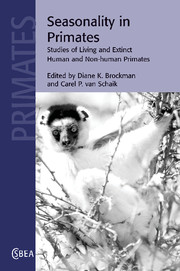Book contents
- Frontmatter
- Contents
- List of contributors
- Preface
- Part I Introduction
- Part II Seasonal habitats
- Part III Seasonality and behavioral ecology
- Part IV Seasonality, reproduction, and social organization
- Part V Seasonality and community ecology
- Part VI Seasonality and human evolution
- 17 Tropical and temperate seasonal influences on human evolution
- 18 Orbital controls on seasonality
- 19 What do studies of seasonality in primates tell us about human evolution?
- Index
- References
19 - What do studies of seasonality in primates tell us about human evolution?
Published online by Cambridge University Press: 10 August 2009
- Frontmatter
- Contents
- List of contributors
- Preface
- Part I Introduction
- Part II Seasonal habitats
- Part III Seasonality and behavioral ecology
- Part IV Seasonality, reproduction, and social organization
- Part V Seasonality and community ecology
- Part VI Seasonality and human evolution
- 17 Tropical and temperate seasonal influences on human evolution
- 18 Orbital controls on seasonality
- 19 What do studies of seasonality in primates tell us about human evolution?
- Index
- References
Summary
Introduction
Seasonality in Primates is about the impact of seasonality on the lives of primates. Because the vast majority of primates live in the tropics, most of the chapters in this book focus on aspects of seasonality in primates, including humans, and early hominins living in the tropics. Contributors to this book explore the various responses of primates to environmental seasonality, and their implications for reconstructing our own journey toward becoming human, beginning some seven million years ago. In this chapter, I synthesize the results of these contributions (Table 19.1) and examine the degree, if any, to which responses of primates to seasonality can be extrapolated to the behavior of extinct humans inhabiting mosaic habitats of the tropics.
It will become readily apparent to the reader that this endeavor yields as many questions as it provides insights, a consequence of an imperfect fossil record, the difficulties inherent in documenting seasonality in the distant past (e.g. see Chapter 8), and the paucity of empirical data available directly linking behavioral responses of hominins to environmental flux. Many of the contributions do, nevertheless, provide predictions of how hominins may have responded to increasing seasonality based upon studies of living primate and human populations, and while evaluations of these predictions are limited, they do provide new directions for future research. An important result that emerges from this synthesis is the proposition that hominins may not have responded in the same way to seasonality as did the other primates.
- Type
- Chapter
- Information
- Seasonality in PrimatesStudies of Living and Extinct Human and Non-Human Primates, pp. 543 - 570Publisher: Cambridge University PressPrint publication year: 2005
References
- 5
- Cited by



